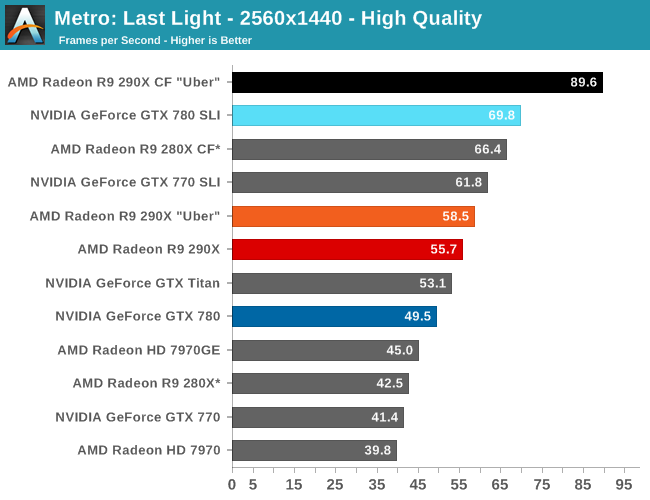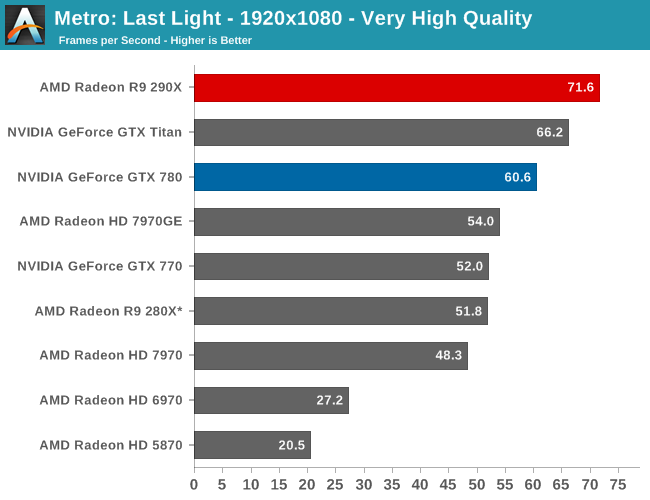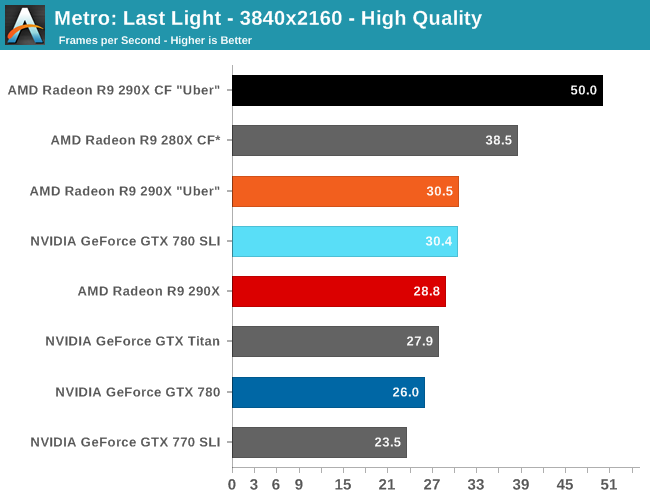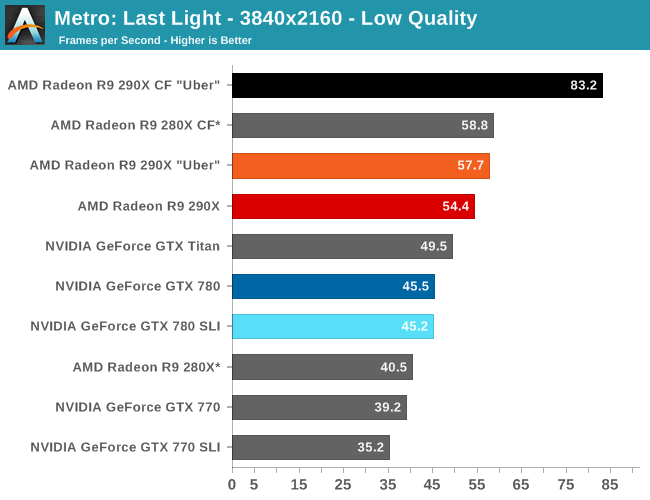The AMD Radeon R9 290X Review
by Ryan Smith on October 24, 2013 12:01 AM EST- Posted in
- GPUs
- AMD
- Radeon
- Hawaii
- Radeon 200
Metro: Last Light
As always, kicking off our look at performance is 4A Games’ latest entry in their Metro series of subterranean shooters, Metro: Last Light. The original Metro: 2033 was a graphically punishing game for its time and Metro: Last Light is in its own right too. On the other hand it scales well with resolution and quality settings, so it’s still playable on lower end hardware.


For the bulk of our analysis we’re going to be focusing on our 2560x1440 results, as monitors at this resolution will be what we expect the 290X to be primarily used with. A single 290X may have the horsepower to drive 4K in at least some situations, but given the current costs of 4K monitors that’s going to be a much different usage scenario.
With that said, for focusing on 4K on most games we’ve thrown in results both at a high quality setting, and a lower quality setting that makes it practical to run at 4K off of a single card. Given current monitor prices it won’t make a ton of sense to try to go with reduced quality settings just to save $550 – and consequently we may not keep the lower quality benchmarks around for future articles – but for the purposes of looking at a new GPU it’s useful to be able to look at single-GPU performance at framerates that are actually playable.
With that said, starting off with Metro at 2560 the 290X hits the ground running on our first benchmark. At 55fps it’s just a bit shy of hitting that 60fps average we love to cling to, but among all of our single-GPU cards it is the fastest, beating even the traditional powerhouse that is GTX Titan. Consequently the performance difference between 290X and GTX 780 (290X’s real competition) is even greater, with the 290X outpacing the GTX 780 by 13%, all the while being $100 cheaper. As we’ll see these results are a bit better than the overall average, but all told we’re not too far off. For as fast as GTX 780 is, 290X is going to be appreciably (if not significantly) faster.
290X also does well for itself compared to the Tahiti based 280X. At 2560 the 290X’s performance advantage stands at 31%, which as we alluded to earlier is greater than the increase in die size, offering solid proof that AMD has improved their performance per mm2 of silicon despite the fact that they’re still on the same 28nm manufacturing process. That 31% does come at a price increase of 83% however, which although normal for this price segment serves as a reminder that the performance increases offered by the fastest video cards with the biggest GPUs do not come cheaply.
Meanwhile for one final AMD comparison, let’s quickly look at the 290X in uber mode. As the 290X is unable to sustain the power/heat workload of a 1000MHz Hawaii GPU for an extended period of time, at its stock (quiet settings) it has to pull back on performance in order to meet reasonable operational parameters. Uber mode on the other hand represents what 290X and the Hawaii can do when fully unleashed; the noise costs won’t be pretty (as we’ll see), but in the process it builds on 290X’s existing leads and increases them by another 5%. And that’s really going to be one of the central narratives for 290X once semi-custom and fully-custom cards come online: Despite being a fully enabled part, 290X does not give us everything Hawaii is truly capable of.


Moving on, let’s talk about multi-GPU setups and 4K. Metro is a solid reminder that not every game scales similarly across different GPUs, and for that matter that not every game is going to significantly benefit from multi-GPU setups. Metro for its part isn’t particularly hospitable to multi-GPU cards, with the best setup scaling by only 53% at 2560. This is better than some games that won’t scale at all, but it won’t be as good as those games that see a near-100% performance improvement. Which consequently is also why we dropped Metro as a power benchmark, as this level of scaling is a poor showcase for the power/temp/noise characteristics of a pair of video cards under full load.
The real story here of course is that it’s another strong showing for AMD at both 2560 and 4K. At 2560 the 290X CF sees better performance scaling than the GTX 780 SLI – 53% versus 41% – further extending the 290X’s lead. Bumping the resolution up to 4K makes things even more lopsided in AMD’s favor, as at this point the NVIDIA cards essentially fail to scale (picking up just 17%) while the 290X sees an even greater scaling factor of 63%. As such for those few who can afford to seriously chase 4K gaming, the 290X is the only viable option in this scenario. And at 50fps average for 4K at high quality, 4K gaming at reasonable (though not maximum) quality settings is in fact attainable when it comes to Metro.
Meanwhile for single-GPU configurations at 4K, 4K is viable, but only at Metro’s lowest quality levels. This will be the first of many games where such a thing is possible, and the first of many games where going up to 4K in this manner further improves on AMD’s lead at 4K. Again, we’re not of the opinion that 4K at these low quality settings is a good way to play games, but it does provide some insight and validationg into AMD’s claims that their hardware is better suited for 4K gaming.










396 Comments
View All Comments
Sandcat - Thursday, October 24, 2013 - link
Perhaps they knew it was unsustainable from the beginning, but short term gains are generally what motivate managers when the develop pricing strategies, because bonus. Make hay whilst the sun shines, or when AMD is 8 months late.chizow - Saturday, October 26, 2013 - link
Possibly, but now they have to deal with the damaged goodwill of some of their most enthusiastic, spendy customers. I can't count how many times I've seen it, someone saying they swore off company X or company Y because they felt they got burned/screwed/fleeced by a single transaction. That is what Nvidia will be dealing with going forward with Titan early adopters.Sancus - Thursday, October 24, 2013 - link
AMD really needs to do better than a response 8 months later to crash anyone's parade. And honestly, I would love to see them put up a fight with Maxwell at a reasonable time period so they have incentive to keep prices lower. Otherwise, expect Nvidia to "overprice" things next generation as well.When they have no competition for 8 months it's not unsustainable to price as high as the market will bear, and there's no real evidence that Titan was economically overpriced because it's not like there was a supply glut of Titans sitting around anywhere, in fact they were often out of stock. So really, Nvidia is just pricing according to the market -- no competition from AMD for 8 months, fastest card with limited supply, why WOULD they price it at anything below $1000?
chizow - Saturday, October 26, 2013 - link
My reply would be that they've never had to price it at $1000 before, and we have certainly seen this level of advancement from one generation to the next in the past (7900GTX to 8800GTX, 8800GTX to GTX 280, 280 GTX to 480 GTX, etc), so it's not completely ground-breaking performance increases even though Kepler overall outperformed historical improvements by ~20%, imo.Also, the concern with Titan isn't just the fact it was priced at ungodly premiums this time around, it's the fact it held it's crown for such a relatively short period of time. Sure Nvidia had no competition at the $500+ range for 8 months, but that was also the brevity of Titan's reign at the top. In the past, a flagship in that $500 or $600+ range would generally reign for the entire generation, especially one that was launched half way through that generation's life cycle. Now Nvidia has already announced a reply with the 780 Ti which will mean not one, but TWO cards will surpass Titan at a fraction of it's price before the generation goes EOL.
Nvidia was clearly blind-sided by Hawaii and ultimately it will cost them customer loyalty, imo.
ZeDestructor - Thursday, October 24, 2013 - link
$1000 cards are fine, since the Titan is a cheap compute unit compared to the Quadro K6000 and the 690 is a dual-GPU card (Dual-GPU has always been in the $800+ range).What we should see is the 780 (Ti?) go down in price and match the R9-290x, much to the rejoicing of all!
Nvidia got away with $650-750 on the 780 because they could, and THAT is why competition is important, and why I pay attention to AMD even if I have no reason to buy from them over Nvidia (driver support on Linux is a joke). Now they have to match. Much of the same happens in the CPU segement.
chizow - Saturday, October 26, 2013 - link
For those that actually bought the Titan as a cheap compute card, sure Titan may have been a good buy, but I doubt most Titan buyers were buying it for compute. It was marketed as a gaming card with supercomputer guts and at the time, there was still much uncertainty whether or not Nvidia would release a GTX gaming card based on GK110.I think Nvidia preyed on these fears and took the opportunity to launch a $1K part, but I knew it was an unsustainable business model for them because it was predicated on the fact Nvidia would be an entire ASIC ahead of AMD and able to match AMD's fastest ASIC (Tahiti) with their 2nd fastest (GK104). Clearly Hawaii has turned that idea on it's head and Nvidia's premium product stack is crashing down in flames.
Now, we will see at least 4 cards (290/290X, 780/780Ti) that all come close to or exceed Titan performance at a fraction of the price, only 8 months after it's launch. Short reign indeed.
TheJian - Friday, October 25, 2013 - link
The market dictates pricing. As they said, they sell every Titan immediately, so they could probably charge more. But that's because it has more value than you seem to understand. It is a PRO CARD at it's core. Are you unaware of what a TESLA is for $2500? It's the same freaking card with 1 more SMX and driver support. $1000 is GENEROUS whether you like it or not. Gamers with PRO intentions laughed when they saw the $1000 price and have been buying them like mad ever since. No parade has been crashed. They will continue to do this pricing model for the foreseeable future as they have proven there is a market for high-end gamers with a PRO APP desire on top. The first run was 100,000 and sold in days. By contrast Asus Rog Ares 2 had 1000 unit first run and didn't sell out like that. At $1500 it really was a ripoff with no PRO side.I think they'll merely need another SMX turned on and 50-100mhz for the next $1000 version which likely comes before xmas :) The PRO perf is what is valued here over a regular card. Your short-lived statement makes no sense. It's been 8 months, a rather long life in gpus when you haven't beaten the 8 month old card in much (I debunked 4k crap already, and pointed to a dozen other games where titan wins at every res). You won't fire up Blender, Premiere, PS CS etc and smoke a titan with 290x either...LOL. You'll find out what the other $450 is for at that point.
chizow - Saturday, October 26, 2013 - link
Yes and as soon as they released the 780, the market corrected itself and Titans were no longer sold out anywhere, clearly a shift indicating the price of the 780 was really what the market was willing to bear.Also, there are more differences with their Tesla counterparts than just 1 SMX, Titan lacks ECC support which makes it an unlikely candidate for serious compute projects. Titan is good for hobby compute, anything serious business or research related is going to spend the extra for Tesla and ECC.
And no, 8-months is not a long time at the top, look at the reigns of previous high-end parts and you will see it is generally longer than this. Even the 580 that preceded it held sway for 14-months before Tahiti took over it's spot. Time at the top is just one part though, the amount which Titan devalued is the bigger concern. When 780 launched 3 months after Titan, you could maybe sell Titan for $800. Now that Hawaii has launched, you could maybe sell it for $700? It's only going to keep going down, what do you think it will sell for once 780Ti beats it outright for $650 or less?
Sandcat - Thursday, October 24, 2013 - link
I noticed your comments on the Tahiti pricing fiasco 2 years ago and generally skip through the comment section to find yours because they're top notch. Exactly what I was thinking with the $550 price point, finally a top-tier card at the right price for 28nm. Long live sanity.chizow - Saturday, October 26, 2013 - link
Thanks! Glad you appreciated the comments, I figured this business model and pricing for Nvidia would be unsustainable, but I thought it wouldn't fall apart until we saw 20nm Maxwell/Pirate Islands parts in 2014. Hawaii definitely accelerated the downfall of Titan and Nvidia's $1K eagle's nest.